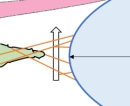
注意)上で「毛様体突起と水晶体との間」と解説しているが、資料によっては、毛様体小帯が毛様体のより広範囲から起きている旨の解説が見られる。また、実際にそのようなイラストを掲載しているサイトも見られる。
「(毛様体小帯は)小帯線維という多数の線維が集まってできている.これは毛様体の全円周から起り,別々の束をなして水晶体被膜の赤道部に達している. 」(Rauber-Kopsh解剖学)
・チン小帯または水晶体小帯とも呼ばれる。
・「眼球前半部を内側から観察すると明瞭である。」(日本人体解剖学)
・「The zonules attach to the lens capsule 2 mm anterior and 1 mm posterior to the equator,」(Wikipedia)



|
|
|
|
|
毛様体小帯・模型図 |
虹彩周辺(断面) |
|
|
|
「 船戸和弥のHP 」では以下のように解説している。
チン小帯ともよばれる。水晶体被膜を毛様体突起に固定する索で、個々の線維を小帯線維という。毛様体突起の比較的後部よりおこる線維は、水晶体赤道の前方に、前方よりおこるものは、後方に付着する。したがって一部線維が交叉する。小帯線維の間に残る小帯隙を経て、後眼房から前眼房へ眼房水が移動する。ドイツの解剖学者Johann Gottifried Zinn (1727-1759)による。)
また以下は「Wikipedia」の解説文となる。
The zonule of Zinn (/ˈtsɪn/) (Zinn's membrane, ciliary zonule) (after Johann Gottfried Zinn) is a ring of fibrous strands forming a zonule (little band) that connects the ciliary body with the crystalline lens of the eye. These fibers are sometimes collectively referred to as the suspensory ligaments of the lens, as they act like suspensory ligaments.
【Development】
The ciliary epithelial cells of the eye probably synthesize portions of the zonules.
【 語 句 】
・strand:要素 ・zonule:小帯 ・ciliary body: ・crystalline:透明な ・collectively:合わせて ・suspensory ligaments:提靱帯 ・ciliary epithelial cells:毛様体上皮細胞 ・synthesize:統合する
【Anatomy】
The zonule of Zinn is split into two layers: a thin layer, which lines the hyaloid fossa, and a thicker layer, which is a collection of zonular fibers. Together, the fibers are known as the suspensory ligament of the lens.The zonules are about 1–2 μm in diameter.
The zonules attach to the lens capsule 2 mm anterior and 1 mm posterior to the equator, and arise of the ciliary epithelium from the pars plana region as well as from the valleys between the ciliary processes in the pars plicata.
When colour granules are displaced from the zonules of Zinn (by friction against the lens), the irises slowly fade. In some cases those colour granules clog the channels and lead to glaucoma pigmentosa.
The zonules are primarily made of fibrillin, a connective tissue protein. Mutations in the fibrillin gene lead to the condition Marfan syndrome, and consequences include an increased risk of lens dislocation.
【 語 句 】
・hyaloid fossa:硝子体窩 ・lens capsule:水晶体包被膜 ・equator:赤道 ・pars plana:毛様体扁平部 ・pars plicata:毛様体ヒダ部 ・granule:細粒 ・iris:虹彩 ・clog:妨害する ・glaucoma:緑内障 ・pigmentosa:色素性 ・fibrillin:フィブリン ・connective tissue protein:結合組織タンパク質 ・mutation:変化、転換、突然変異 ・Marfan syndrome:マルファン症候群 ・consequence:結果、結論 ・lens dislocation:水晶体脱臼
【Clinical appearance】
The zonules of Zinn are difficult to visualize using a slit lamp, but may be seen with exceptional dilation of the pupil, or if a coloboma of the iris or a subluxation of the lens is present. The number of zonules present in a person appears to decrease with age. The zonules insert around the outer margin of the lens (equator), both anteriorly and posteriorly.
【Function】
Securing the lens to the optical axis and transferring forces from the ciliary muscle in accommodation. When colour granules are displaced from the zonules of Zinn, caused by friction of the lens, the iris can slowly fade. These colour granules can clog the channels and lead to glaucoma pigmentosa.
【 語 句 】
・slit lamp:細隙灯 ・dilation:拡張、散大 ・pupil:瞳孔 ・coloboma:眼欠損症 ・subluxation:亜脱臼 ・optical axis:左軸 ・friction:摩擦
■ 写真やイラストを掲載しているサイト ■
・ イラストや写真を掲載しているサイト-Ⅰ
・ イラストや写真を掲載しているサイト-Ⅱ
・ イラストや写真を掲載しているサイト-Ⅲ
・ イラストや写真を掲載しているサイト-Ⅳ
・ イラストや写真を掲載しているサイト-Ⅴ
